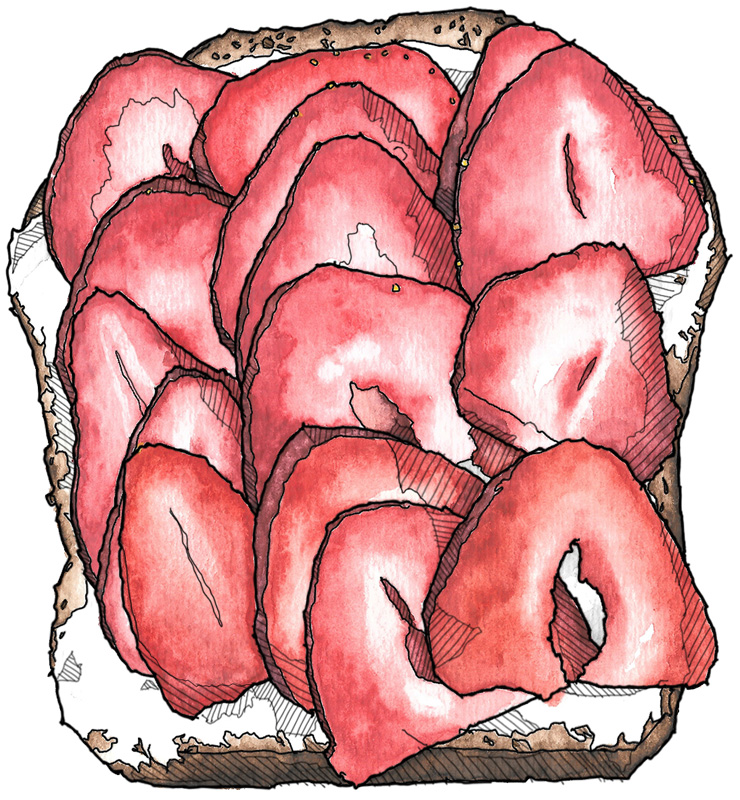Growing up in the Seventies on the Island, I remember eating a lot of Birds Eye frozen veggies. We ate frozen vegetables because back then, supermarkets only stocked produce that was in season locally — nothing was getting trucked in from anywhere else. Even in season, there weren’t any farmstands until the West Tisbury Farmers Market opened in 1974. The choice was limited. We now live in a world market where asparagus and blueberries are available all winter, with much coming from South and Central America, California, and Mexico.
I think we all know there is no comparison with eating fresh, local food in-season. Fruit and vegetables from your local region picked when ripe and lightly traveled are (do we even need to say this?) far superior to fruits and vegetables picked before ripeness, then flown or trucked thousands of miles, arriving with a faded taste and usually harder texture. At the very least. But you tolerate it because having something green and alive in the middle of winter is like a ray of sunshine. But there is one thing I absolutely will not eat unless it’s local, and that’s strawberries.
I say don’t bother with strawberries except when they’re in season, and from your local growing region. Biting into a late spring strawberry is soft and crazy-juicy, a stainmaker for sure. They are sweet with a tinge of tart. They smash in your mouth. When freshly picked they are warm to bite into. They are delicate and bold. They come in like a freight train in the spring, prolific for a short, fleeting moment, and in the Northeast, gone by summer. Do you get that I like local strawberries?
If you need more convincing about why to go local or organic: Big commercial-farm strawberries are known to have loads of chemicals, which has put strawberries at the top of the dirty dozen, a list of the worst foods (bit.ly/BadFOOD) to consume because of chemicals, fumigants, and pesticides.
If you are buying commercial, then by all means, go organic, but if you are as lucky as we are here on the Island, with so many farms that practice responsible growing and farming, local is the best.
On Martha’s Vineyard, the biggest producer of strawberries is Morning Glory Farm in Edgartown. Jim and Debbie Athearn started Morning Glory Farm in 1975. They were originally dairy farmers who started to grow vegetables. As dairy farms faded on the Vineyard, the demand for vegetables grew larger, and so did Morning Glory. The Athearns raised their three children, Simon, Prudence, and Daniel, on the farm.
Today at the helm is the next generation. Simon is the CEO and Daniel is COO, though Jim and Debbie are very much present on the farm.
According to Simon, Morning Glory manages 200 acres, growing hay for the animals, cover crops, and pretty much every vegetable you could want. Sweet corn is their biggest food crop.
Morning Glory is pretty much nonstop from the time they open in May until their season ends after Christmas. For me, I wait for the fleeting strawberry season in June. Though the single acre of strawberries Morning Glory grows each year seems small compared with some of the bigger crops, they still produced over 2,400 pints last season.
Simon explains that because strawberries are perennials, they have three fields going at once:
two fields fruiting and one newly planted for the next season. Strawberry plants fruit for two years, then are plowed under to start again. Morning Glory has been improving their growing techniques, with high-density pruning, creating almost a bush, rather than the typical flattened plant that has arms growing everywhere in the dirt, making the plant vulnerable to weather and birds. They are also working on an additional fall planting, which appears to be successful thus far.
“Strawberries are a real hassle to grow,” Daniel Athearn says. “Because they are perennials, this means you need to maintain them all year, mulch them, covering them with straw in the winter to protect the crown from getting frozen — it also ends up keeping the berries from getting dirty in the spring.”
Simon asks his brother what his favorite variety is. “It’s not so much the variety as the timing,” Daniel says. “They get better as the season goes: Basically as the plants are about to fail, strawberries are at their sweetest, and have the most sugar.”
Simon agrees. “Strawberries crop for about five to seven days per variety. We feel like you have to pick them every single day — they have to be dead perfect coming off the vine. You pick impeccable red berries, with no green tips, and anything slightly overripe will be bruised by your fingers.”
Morning Glory grows seven varieties of strawberries, kicking off around June 10, and stage growing so they get the most out of this intense short season, which ends around July 4.
Every year the farm celebrates the harvest with a strawberry festival, which this year falls on June 22nd at the farm stand (bit.ly/MoGloStrawberries).
Here’s one of my favorite things to do with my local strawberries.

Fresh Strawberry Toast
2 slices bread for toasting: Find something really fresh, not processed if possible strawberries ¼ cup Mermaid Farm Fromage ½ tsp. grated lemon zest 1 Tbsp. maple syrup raw sugar to top
Lightly toast two slices of bread.
Remove stems and slice strawberries lengthwise; put aside in a bowl to sit for about 15 minutes until room temperature.
Use about ¼ cup Mermaid Farm Fromage for two slices of toast
In a bowl combine ½ teaspoon grated lemon zest, 1 tablespoon maple syrup, and Fromage.
Spread Fromage mixture on toast, and add sliced strawberries. Sprinkle a touch of raw sugar over the top.
Consider wearing a bib.

